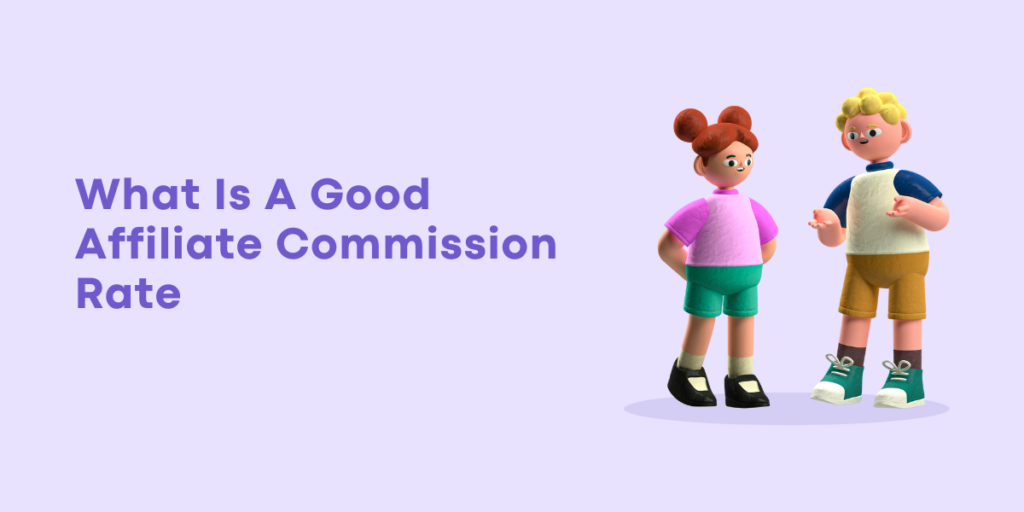What Is An Affiliate Commission?
In the world of online marketing, the concept of affiliate commissions plays a pivotal role. But what exactly is an affiliate commission? Let’s delve into this topic and uncover its significance in the digital landscape.
Affiliate commission refers to the monetary compensation earned by individuals or businesses, known as affiliates, for promoting and driving sales or leads to another company’s products or services. These affiliates act as intermediaries between the company and potential customers, leveraging their marketing skills to generate interest and ultimately encourage conversions.
What is a Good Affiliate Commission Rate? Typically ranging from 5% to 30%, the average affiliate commission rate varies. Initially, many businesses opt for lower rates, gradually increasing them as their company expands. Striking a balance is crucial, aiming for a rate that appeals to affiliates while remaining financially feasible for the business.

Benefits Of An Affiliate Commission
Affiliate commissions offer a multitude of benefits to both affiliates and companies alike. Let’s explore some of the advantages that make affiliate marketing an attractive strategy for many businesses.
- Cost-Effective Marketing: Companies can leverage the power of affiliate marketing to expand their reach without bearing the full cost of traditional advertising. Instead of allocating a hefty budget to widespread marketing campaigns, businesses only pay affiliates when they successfully generate sales or leads. This performance-based model ensures that marketing expenses are directly tied to measurable results.
- Increased Brand Exposure: By partnering with affiliates, businesses can tap into new audiences and expose their brand to a wider consumer base. Affiliates often have their own established platforms, such as websites, blogs, or social media channels, which provide valuable opportunities for brand promotion. This expanded exposure can lead to heightened brand awareness and an influx of potential customers.
- Targeted Marketing: Affiliates often specialize in specific niches or industries, allowing companies to target their ideal customer segments more effectively. By collaborating with affiliates who cater to a particular audience, businesses can tailor their marketing efforts and messages to resonate with the desired customer base. This targeted approach increases the likelihood of conversions and maximizes the return on investment (ROI).
- Performance-Based Motivation: Affiliate marketing creates a win-win scenario for affiliates and companies. Affiliates are incentivized to put in their best efforts to drive sales or leads since their earnings directly correlate with their performance. This motivation fosters a sense of dedication and commitment among affiliates, leading to increased promotional activities and ultimately higher conversions for the company.
Factors That Impact Good Affiliate Commission
Several factors come into play when determining what constitutes a good affiliate commission. Let’s explore some key considerations that can influence the effectiveness and attractiveness of an affiliate commission structure.
- Product or Service Profitability: The profitability of the promoted product or service significantly affects the commission rates that can be offered to affiliates. Higher-margin products or services allow companies to allocate a larger percentage of the sale price as a commission. Conversely, low-margin products may necessitate lower commission rates to maintain profitability.
- Average Order Value: The average order value (AOV) represents the typical amount spent by customers when making a purchase. A higher AOV provides an opportunity to offer more substantial commissions to affiliates. However, it’s crucial to strike a balance between attractive commission rates and maintaining a competitive price point to ensure customer satisfaction and repeat business.
- Conversion Rate: The conversion rate refers to the percentage of visitors or leads that successfully convert into paying customers. A high conversion rate indicates that the affiliate’s promotional efforts are effective in driving sales. Companies may choose to offer higher commission rates for affiliates who consistently deliver conversions above a certain threshold, as their efforts contribute directly to revenue generation.
- Industry Norms: It’s essential to consider industry norms and benchmarks when determining the commission rates for affiliates. Researching and analyzing the commission structures prevalent in the industry can provide valuable insights into what competitors offer and help strike a balance between attractiveness and sustainability.
Types Of Affiliate Commissions
Affiliate marketing is a popular and lucrative avenue for individuals and businesses to generate income online. It involves promoting products or services on behalf of a company and earning a commission for every successful referral or sale. When venturing into the world of affiliate marketing, understanding the various types of commission structures is essential. We will delve into the four main types of affiliate payments, shedding light on their mechanics and helping you determine what constitutes a good affiliate commission rate.
Pay-Per-Click (PPC)
Pay-Per-Click, commonly known as PPC, is a commission model where affiliates earn money for each click their referral generates. This type of commission structure is often associated with advertisements or sponsored content, where the affiliate’s role is to drive traffic to the advertiser’s website. The advantage of PPC is that affiliates can earn money without the need for a sale to occur. However, the downside is that the commission per click is usually relatively low compared to other models.
Pay-Per-Action (PPA)
Pay-Per-Action, or PPA, is a commission structure that offers rewards when a specific action is taken by the referred customer. This action can vary depending on the advertiser’s goals and may include signing up for a newsletter, filling out a form, or making a purchase. PPA commissions are typically higher than PPC, as they require a more substantial level of engagement from the customer. This model aligns well with advertisers who are looking for targeted leads and measurable results.
Pay-Per-Impression (PPI)
Pay-Per-Impression, known as PPI, is a commission structure based on the number of times an ad or promotional material is displayed to an audience. In this model, affiliates earn a commission for every thousand impressions their referral generates. PPI is often used in display advertising campaigns, where the goal is to increase brand exposure and visibility. It is important to note that PPI commissions are generally lower than other models since they rely on impressions rather than concrete actions or sales.
Two-Tier Affiliate Programs (TTAP)
- Two-Tier Affiliate Programs, also referred to as TTAP, offer a unique commission structure that allows affiliates to earn not only from their direct referrals but also from the affiliates they recruit. This model encourages affiliates to build a network of sub-affiliates, leveraging their efforts to generate additional income. TTAP commissions can vary significantly, depending on the program and the value of the sales generated by both direct and indirect referrals.
FAQs:
What is the average commission for affiliates?
The average commission for affiliates varies between 5% and 30%, depending on the program and industry.
What is a good affiliate conversion rate?
A good affiliate conversion rate is typically considered to be around 2% to 5%, although it can vary significantly depending on the product, niche, and marketing strategy.
How much can you realistically make with affiliate marketing?
The potential earnings in affiliate marketing vary greatly and depend on several factors, such as the commission rate, the price of the product or service being promoted, the conversion rate, and the volume of traffic. Realistically, earnings can range from a few hundred dollars per month to several thousand or even more for successful affiliates.



